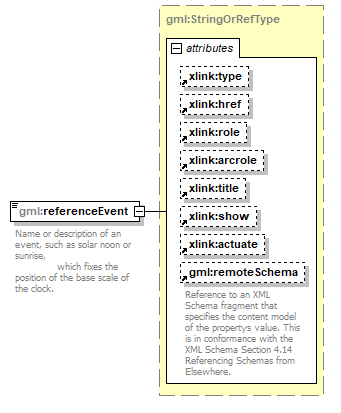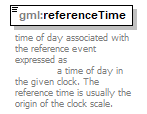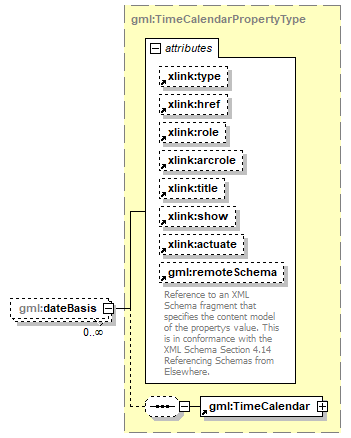| diagram |  |
||||||||||||||
| namespace | http://www.opengis.net/gml | ||||||||||||||
| type | extension of gml:AbstractTimeReferenceSystemType | ||||||||||||||
| properties |
|
||||||||||||||
| children | gml:metaDataProperty gml:description gml:name gml:domainOfValidity gml:referenceEvent gml:referenceTime gml:utcReference gml:dateBasis | ||||||||||||||
| used by |
|
||||||||||||||
| attributes |
|
||||||||||||||
| annotation |
|
||||||||||||||
| source | <xs:complexType name="TimeClockType" final="#all"> <xs:annotation> <xs:documentation xml:lang="en">A clock provides a basis for defining temporal position within a day. A clock must be used with a calendar in order to provide a complete description of a temporal position within a specific day.</xs:documentation> </xs:annotation> <xs:complexContent> <xs:extension base="gml:AbstractTimeReferenceSystemType"> <xs:sequence> <xs:element name="referenceEvent" type="gml:StringOrRefType"> <xs:annotation> <xs:documentation>Name or description of an event, such as solar noon or sunrise, which fixes the position of the base scale of the clock.</xs:documentation> </xs:annotation> </xs:element> <xs:element name="referenceTime" type="time"> <xs:annotation> <xs:documentation>time of day associated with the reference event expressed as a time of day in the given clock. The reference time is usually the origin of the clock scale.</xs:documentation> </xs:annotation> </xs:element> <xs:element name="utcReference" type="time"> <xs:annotation> <xs:documentation>24 hour local or UTC time that corresponds to the reference time.</xs:documentation> </xs:annotation> </xs:element> <xs:element name="dateBasis" type="gml:TimeCalendarPropertyType" minOccurs="0" maxOccurs="unbounded"/> </xs:sequence> </xs:extension> </xs:complexContent> </xs:complexType> |
element TimeClockType/referenceEvent
| diagram |  |
||||||||||||||||||||||||||||||||||||||||||||||||||||||||
| namespace | http://www.opengis.net/gml | ||||||||||||||||||||||||||||||||||||||||||||||||||||||||
| type | gml:StringOrRefType | ||||||||||||||||||||||||||||||||||||||||||||||||||||||||
| properties |
|
||||||||||||||||||||||||||||||||||||||||||||||||||||||||
| attributes |
|
||||||||||||||||||||||||||||||||||||||||||||||||||||||||
| annotation |
|
||||||||||||||||||||||||||||||||||||||||||||||||||||||||
| source | <xs:element name="referenceEvent" type="gml:StringOrRefType"> <xs:annotation> <xs:documentation>Name or description of an event, such as solar noon or sunrise, which fixes the position of the base scale of the clock.</xs:documentation> </xs:annotation> </xs:element> |
element TimeClockType/referenceTime
| diagram |  |
||||
| namespace | http://www.opengis.net/gml | ||||
| type | xs:time | ||||
| properties |
|
||||
| annotation |
|
||||
| source | <xs:element name="referenceTime" type="time"> <xs:annotation> <xs:documentation>time of day associated with the reference event expressed as a time of day in the given clock. The reference time is usually the origin of the clock scale.</xs:documentation> </xs:annotation> </xs:element> |
element TimeClockType/utcReference
| diagram |  |
||||
| namespace | http://www.opengis.net/gml | ||||
| type | xs:time | ||||
| properties |
|
||||
| annotation |
|
||||
| source | <xs:element name="utcReference" type="time"> <xs:annotation> <xs:documentation>24 hour local or UTC time that corresponds to the reference time.</xs:documentation> </xs:annotation> </xs:element> |
element TimeClockType/dateBasis
| diagram |  |
||||||||||||||||||||||||||||||||||||||||||||||||||||||||
| namespace | http://www.opengis.net/gml | ||||||||||||||||||||||||||||||||||||||||||||||||||||||||
| type | gml:TimeCalendarPropertyType | ||||||||||||||||||||||||||||||||||||||||||||||||||||||||
| properties |
|
||||||||||||||||||||||||||||||||||||||||||||||||||||||||
| children | gml:TimeCalendar | ||||||||||||||||||||||||||||||||||||||||||||||||||||||||
| attributes |
|
||||||||||||||||||||||||||||||||||||||||||||||||||||||||
| source | <xs:element name="dateBasis" type="gml:TimeCalendarPropertyType" minOccurs="0" maxOccurs="unbounded"/> |
XML Schema documentation generated by XMLSpy Schema Editor http://www.altova.com/xmlspy